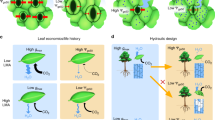Summary
The recent explosion of information on stomatal action has led to a rejection of the old, classical theory of the mechanism, proposed byScarth (1932) and its replacement byFujino's (1959) concept of active K+ transport. Many of the new facts, however, do not seem to fit into either concept, and neither provides a sufficiently detailed, step-by-step scheme to account for all the known facts. Enough information is now available for the proposal of a new scheme which embodies the best features of each of the above and eliminates the inadequacies of both.
There are five main kinds of stomatal movement: 1. photoactive opening, 2. hydroactive opening, 3. hydroactive closing, 4. scotoactive closing, and 5. scotoactive opening. The hydroactive opening and closing, in principle, are simply due to the passive flow of water along activity gradients and, therefore, do not require theoretical analysis. Any theory of stomatal movement, to be fully adequate, must provide a sound, step-by-step explanation for all the remaining three kinds of movement.
Similar content being viewed by others
References
Allaway, W. G., 1973: Accumulation of malate in guard cells ofVicia faba during stomatal opening. Planta110, 63–70.
Coombs, J., andC. W. Baldry, 1972: C-4 pathway inPennisetum purpureum. Nature, New Biology238, 268–270.
Davies, P. J., 1973: Current theories of the mode of action of auxin. Bot. Rev.39, 139–171.
Ehrler, W. L., 1971: Periodic nocturnal stomatal opening ofCitrus in a steady environment. Physiol. Plant.25, 488–492.
Fischer, R. A., 1968: Stomatal opening: role of potassium uptake by guard cells. Science160, 784–785.
—, andT. C. Hsiao, 1968: Stomatal opening in isolated epidermal strips ofVicia faba. II. Responses to KCl concentration and the role of potassium absorption. Plant Physiol.43, 1953–1958.
Frommhold, I., 1971: Ontogenetische und funktioneile Entwicklung der Stomata von Hafer (Avena sativa L.). Biochem. Physiol. Pflanz. (BPP)162, 410–416.
Fujino, M., 1959: Stomatal movement and active migration of potassium (in Japanese). Kagaku29, 660–661.
Hanebuth, W. F., andK. Raschke, 1973: Stomatal aperture inZea mays controlled by light or CO2? Plant Physiol. (suppl.)51, 9.
Heldt, H. W., K. Werden, M. Milovancev, andG. Geller, 1973: Alkalization of the chloroplast stroma caused by light dependent proton flux into the thylakoid space. Biochim. biophys. Acta314, 224–241.
Huber, S. C., R. Kanai, andG. E. Edwards, 1973: Decarboxylation of malate by isolated bundle-sheath cells of certain plants having the C4-dicarboxylic acid cycle of photosynthesis. Planta113, 53–66.
Humble, G. D., andT. C. Hsiao, 1970: Light-dependent influx and efflux of potassium of guard cells during stomatal opening and closing. Plant Physiol.46, 483–487.
—, andK. Raschke, 1971: Stomatal opening quantitatively related to potassium transport. Evidence from electron probe analysis. Plant Physiol.48, 447–453.
Imamura, S., 1943: Untersuchungen über den Mechanismus der Turgorschwankung der Spaltöffnungsschlie\zellen. Jap. J. Bot.12, 251–346.
Kanai, R., andG. E. Edwards, 1973: Enzymatic separation of mesophyll protoplasts and bundle sheath cells from C4 plants. Naturwiss.60, 157–158.
Levitt, J., 1967: The mechanism of stomatal action. Planta74, 101–118.
Mouravieff, I., 1971: Les inhibiteurs des groupes thiols empechent l'ouverture des ostioles stomatiques. Importance probable des glyceraldehyde-phosphate déshydrogénases. Physiol. Vég.9, 109–118.
Pallaghy, C. K., 1971: Stomatal movement and potassium transport in epidermal strips ofzea mays: The effect of CO2. Planta101, 287–295.
Pallas, J. E., Jr., 1964: Guard cell starch retention and accumulation in the dark. Bot. Gaz.125, 102–107.
—, 1969: Endogenous diurnal and nocturnal activity of guard cells as indicated by stomatal aperture and protoplasmic streaming. Physiol. Plant.22, 546–559.
—, andB. G. Wright, 1973: Organic acid changes in the epidermis ofVicia faba and their implication in stomatal movement. Plant Physiol.51, 588–590.
—, andR. A. Dilley, 1972: Photophosphorylation can provide sufficient adenosine 5′—triphosphate to drive K+ movements during stomatal opening. Plant Physiol.49, 649–650.
Pick, U., H. Rottenberg, andM. Avron, 1973: Effect of phosphorylation on the size of the proton gradient across chloroplast membranes. FEBS Letters32, 91–94.
Raschke, K., andM. P. Fellows, 1971: Stomatal movement inZea mays: Shuttle of potassium and chloride between guard cells and subsidiary cells. Planta101, 296–316.
Rayle, D. L., 1973: Auxin-induced hydrogen-ion secretion inAvena coleoptiles and its implications. Planta114, 63–73.
Sawhney, B. L., andI. Zelitch, 1969: Direct determination of potassium ion accumulation in guard cells in relation to stomatal opening in light. Plant Physiol.44, 1350–1354.
Scarth, G. W., 1927: Stomatal movement: its regulation and regulatory role. A review. Protoplasma2, 498–511.
—, 1932: Mechanism of the action of light and other factors on stomatal movement. Plant Physiol.7, 481–504.
—, andM. Shaw, 1951: Stomatal movement and photosynthesis inPelargonium. I. Effects of light and carbon dioxide. Plant Physiol.26, 207–225.
Schuldiner, S., H. Rottenberg, andM. Avron, 1973: Stimulation of ATP synthesis by a membrane potential in chloroplasts. Eur. J. Biochem.39, 455–462.
Shaw, M., 1954: Chloroplasts in the stomata ofAllium cepa L. New Phyt.53, 344–348.
—, andG. A. MacLachlan, 1954: The physiology of stomata. I. Carbon dioxide fixation in guard cells. Canad. J. Bot.32, 784–794.
Siegal, M. I., M. Wishnick, andM. D. Lane, 1972: Ribulose-1,5-diphosphate carboxylase. In: The Enzymes VI., pp. 169–192 (P. D. Boyer, ed.). Third Ed. New York: Academic Press.
Thomas, D. A., 1970: The regulation of stomatal aperture in tobacco leaf epidermal strips. II. The effect of ouabain. Aust. J. biol. Sci.23, 981–989.
Thomas, D. A., 1971: The regulation of stomatal aperture in tobacco leaf epidermal strips. III. The effect of ATP. Aust. J. biol. Sci.24, 689–707.
Utter, M. F., andH. M. Kolenbrander, 1972: Formation of oxalacetate by CO2 fixation on phosphoenolpyruvate. In: The Enzymes VI., pp. 117–168 (P. D. Boyer, ed.). Third Ed. New York: Academic Press.
Willmer, C. M., andJ. E. Pallas, Jr., 1973: A survey of stomatal movements and associated potassium fluxes in the plant kingdom. Canad. J. Bot.51, 37–42.
Willmer, C, R. Kanai, J. E. Pallas, Jr., andC. C. Black, Jr., 1973: Detection of high levels of phosphoenolpyruvate carboxylase in leaf epidermal tissue and its significance in stomatal movements. Life Sci.12, 151–155.
Author information
Authors and Affiliations
Rights and permissions
About this article
Cite this article
Levitt, J. The mechanism of stomatal movement—Once more. Protoplasma 82, 1–17 (1974). https://doi.org/10.1007/BF01276868
Received:
Issue Date:
DOI: https://doi.org/10.1007/BF01276868




